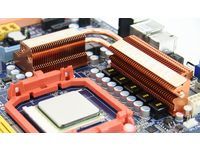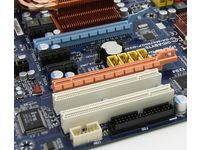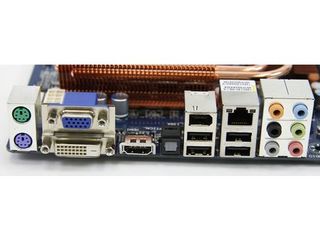AMD 790GX: RV610 For Enthusiasts?
Gigabyte’s MA790GP-DS4H
Originally, this story was slated to be a round-up of four 790GX-based boards AMD claimed would be available at launch. It was to be glorious, we swear. Unfortunately, the stars did not align as we had expected, and only one motherboard made it to our facilities for testing: Gigabyte’s MA790GP-DS4H. The ASUS, Foxconn, and MSI boards simply were not ready in time.
As a matter of fact, we actually received two Gigabyte MA790GP-DS4Hs — one from Gigabyte and another that had gone through AMD’s own QA lab. The first Gigabyte board was based on PCB revision .2 and had some noticeable teething problems. In a number of 3D apps, the screen would scramble, sometimes righting itself and other times requiring a reboot. As expected, the revision 1.0 board behaved in a much more civilized manner. We have to wonder if some of the other vendors’ offerings experienced similar issues.

Mainstream For Enthusiasts
The MA790GP-DS4H is probably the highest-end mainstream platform you’ve ever seen. We already know it was built to be a value-oriented offering (hence the integrated graphics, 4+1 phase power, and VGA output). But there are more performance indicators here to tantalize a more affluent customer: copper cooling, dual graphics slots, 128 MB of onboard DDR3, for instance.
Clearly, AMD’s partners have learned from their experiences with 780G. Early in 2008, AnandTech’s Gary Key reported on issues he experienced testing 780G-based board with 125 W quad-core Phenom processors. The problem turned out to be power circuitry on the mainstream boards that wasn’t sufficient for higher-end CPUs, leading to premature board failure. This time around, those same vendors aren’t “going cheap,” instead beefing up power circuitry to cope with everything right up to the 140 W Phenom X4 9950 Black Edition. Gigabyte’s 790GX board features a 4+1-phase configuration, and we suspect other third-party vendors will follow suit.

A passive copper cooler sits atop the MA790GP-DS4H’s power circuitry and connects via heatpipe to another copper sink responsible for cooling AMD’s northbridge. Under that cooler (but not touching it) is a 128 MB module of Elpida DDR3-1333 memory — the side-port cache used to improve integrated graphics performance. If you plan on adding a Radeon HD 3450 or 3470 to the board (harnessing the Hybrid CrossFireX feature), use the blue PCI Express x16 slot. Should you instead opt for straight CrossFireX, circumventing the onboard core altogether, a pair of similar cards plugged into the blue and orange slots will get eight lanes of PCIe 2.0 connectivity each.
There are actually a reasonable number of integrated extras — as well there should be for the cost difference between 780G and 790GX. Gigabyte includes Realtek’s 8111C Gigabit Ethernet controller (good, since the 790GX doesn’t have its own networking link), a Realtek 889A codec (Dolby Home Theater is offered, including Dolby Digital Live encoding), and a Texas Instruments FireWire controller. There aren’t any extra storage controllers, but because AMD now supports RAID 0, 1, 10, and 5 through the six SATA ports originating from its SB750, we’re hardly concerned with additional storage on a mainstream platform.
Stay on the Cutting Edge
Join the experts who read Tom's Hardware for the inside track on enthusiast PC tech news — and have for over 25 years. We'll send breaking news and in-depth reviews of CPUs, GPUs, AI, maker hardware and more straight to your inbox.

The board’s back panel plays host to standard PS/2 ports, VGA, HDMI, and DVI outputs (remember, only one analog and one digital output can be used at a time), four USB 2.0 ports, one FireWire connector, Gigabit Ethernet, optical audio output, and enough 1/8” analog jacks for 8.1-channel connectivity. Gigabyte goes the extra mile by also including its DualBIOS feature — a lifesaver if you ever hose the update procedure — and solid capacitors across the entire board.
Current page: Gigabyte’s MA790GP-DS4H
Prev Page A Chipset With its Own Software? Next Page Test Setup-
kitsilencer Great review, and it's good to see that AMD is at last able to target more enthusiast markets competitively.Reply -
cangelini kitsilencerGreat review, and it's good to see that AMD is at last able to target more enthusiast markets competitively.Reply
Thanks for the feedback Kit. -
waffle911 So... why does a page 15 and 16 of this article exist if there is no page 15 or 16 to the article?Reply
Take a closer look. What happened? -
YYD PCMark seems Intel biased, please read this:Reply
http://arstechnica.com/reviews/hardware/atom-nano-review.ars/6
Please change this benchmark suite or check if PcMark Vantage is unbiased. -
cangelini waffle911So... why does a page 15 and 16 of this article exist if there is no page 15 or 16 to the article?Take a closer look. What happened?Reply
That was strange. Should be fixed now.
-
cangelini YYDPCMark seems Intel biased, please read this:http://arstechnica.com/reviews/har view.ars/6Please change this benchmark suite or check if PcMark Vantage is unbiased.Reply
Fortunately, with no Intel platforms tested, this should be a non-issue for the current situation ;-) In the future, you'll be seeing SYSmark, though. -
Seems past page 8 or something the links are corrupt.. can't fully read this article and getting error 404 - page not found.Reply
-
cangelini lacrits.. and now the article seems to be removed even from the main page!?!?!Reply
Alright, mystery solved. It's back up, sans the blank page. Thanks for pointing that out lacrits!
Most Popular


